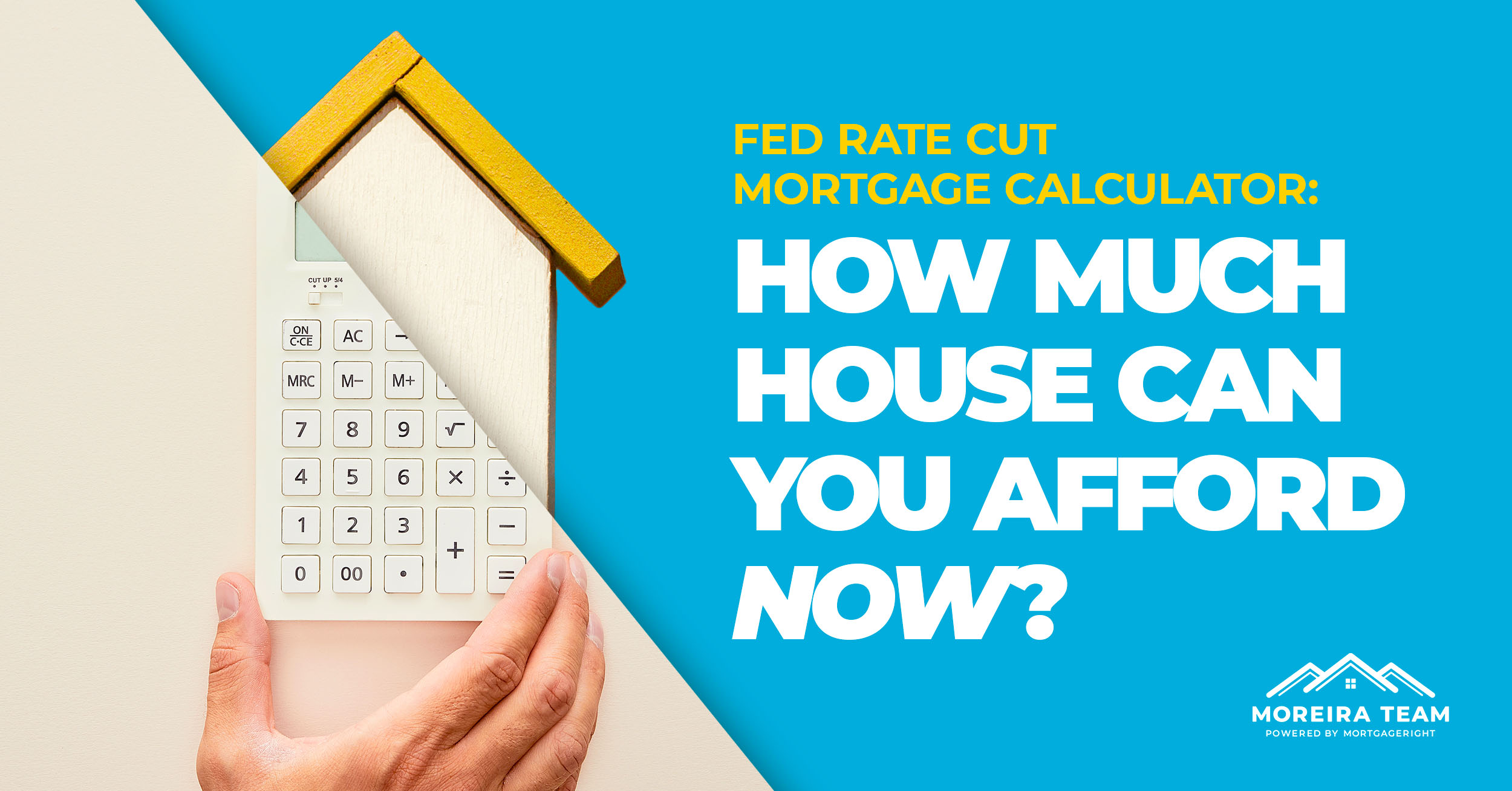
In this article
Whether you’re a first time home buyer or looking to refinance your loan, it can feel daunting trying to negotiate favorable loan terms in an ever-evolving housing market. Mortgage rates can be hard to predict, and it may seem like you’re constantly at the whims of economic forces beyond your control.
That’s why it’s important to make the most of the recent Federal Reserve mortgage rate cut and understand how the cut, and future rate changes, can impact your mortgage options.

With mortgage rates reaching their lowest point in over a year, now is an important time to learn how to recalculate your mortgage affordability and loan terms, adjusting for these new rates.
Moreira Team’s mortgage calculator is an online tool that can help you make this adjustment quickly and easily, so you can understand what you can afford and see what your new payment might look like with the updated numbers.
Here’s what you should know about the new Fed rate cut, how it impacts your mortgage options, and how our mortgage calculator can help you prepare for the next steps of your home buyer’s journey.
Get your fast and free rate quote. Start Here! (Dec 14th, 2025)Impact of the New Fed Rate Cut
The current mortgage rate of 6.2%, as of the writing of this article, remains higher than before the COVID-19 pandemic. Yet rates are steadily declining and are the lowest they’ve been since early 2023. According to the Mortgage Bankers Association, rates are predicted to level out at 6.4% this year, versus 7.19% reported by Freddie Mac at this time last year. These rates are based on a 30-year fixed-rate mortgage.
Forbes reports that rates will continue to drop after “the Federal Reserve cut short-term interest rates by 0.50% or 50 basis points for the first time since the onset of the pandemic.” This is the first major rate cut by the Federal Reserve in several years.
For comparison, rates for a 30-year fixed-rate mortgage reached a record low of less than 3% after the onset of the pandemic in 2020.
Still, the recent cut spells some important positive takeaways for homebuyers and those looking to refinance an existing home loan. Let’s take a look at some of the key facts surrounding the recent rate cut.
See exactly how much you can afford. Start Here! (Dec 14th, 2025)Affordability for First-Time Homebuyers
Outside market factors like increased demand versus the current lack of supply of housing in the United States may keep home prices high in the short term, despite dropping mortgage rates.
However, lower interest rates coupled with future Fed rate cuts could lead to an increase in supply, as this incentivizes developers to build more homes, and those with improved refinancing options may also choose to sell.
Additionally, despite still high home costs, lower mortgage rates increase your purchasing power as a borrower. With lower rates, you have the potential to secure a larger loan at a comparable monthly payment versus more limited purchasing power when rates are higher.
Example: an interest rate of 6%, with an annual income of $65,000, monthly debt of $500, and annual property taxes and home insurance at $2,400 each, you could potentially afford a 30-year mortgage of $275,115 with a total monthly payment of $2,208.33.
Get custom rate and closing cost options in less than a minute. Start Here! (Dec 14th, 2025)Refinancing
While those who refinanced in years when mortgage rates were much lower are unlikely to do so now, it can still be an attractive option for many. Much of the decision to refinance will be based on individual factors like:
- your current loan rate and other loan conditions
- how adjusting to a shorter loan term impacts monthly payments
- cash-out options based on your home equity
- overall savings versus the closing costs of a refinance
- if you plan on staying in the home or will move in the near future
Example: Say you have a current balance of $260,000 on a 30-year fixed-rate mortgage acquired in 2018, at a rate of 7.125%. A refinance at a rate of 6%, with $4,000 in refinance fees, lowers the loan balance to $230,000 and a monthly savings of $372.70.
Customized refinance rates in less than a minute. Start Here! (Dec 14th, 2025)The “You” Factor
Ultimately, securing favorable loan terms depends on a combination of market forces and personal financial factors like credit score and income, as well as other qualifying factors. Taking advantage of lower mortgage rates can depend on knowing how your needs and preferences intersect with the loan conditions you qualify for.
- Credit scores – Coupled with income, credit plays a major role in terms of the loan programs you qualify for as a homebuyer. A credit score above 620 is typically required to qualify for a conventional home loan, and above 700 can help you secure better loan terms, such as a lower down payment and reduced closing costs, for most types of mortgages.
- Savings – The more money you have saved for a down payment on a home, the better your “loan-to-value,” which can allow you to more easily cover closing costs and secure favorable loan terms, including lower monthly payments, better interest rates, more home equity, and less overall interest and debt.
- Other factors – Loan eligibility can depend on factors like the types of loan programs, such as conventional loans versus income-based FHA loans with lower down payments, VA loans for military members, or USDA loans for homes in certain rural areas. Also, consider whether you’re seeking a longer or shorter loan term and the associated risks and benefits.
Mortgage Calculator: How to Recalculate Your Home Buying Power
Finding out how much you can afford when buying a home or refinancing an existing mortgage after the recent Fed rate cut is easier than ever when using our mortgage calculator tool. Discover what your payments would look like over the lifetime of your new loan.
Give our mortgage calculator a try today.
In light of the recent Fed rate cut, now is the time to crunch the numbers to understand your options and plan your next move.
Here’s a step-by-step guide for using our mortgage calculator.
- Home price: This is the price you agree to pay for the mortgage on a home, based on what you can afford and qualify for. If you aren’t sure how to calculate this, use the purchase affordability calculator where you can input your salary, monthly debt, current mortgage rate, and other pricing factors to determine what you can afford.
- Down payment: A down payment of at least 20% is recommended in most cases, but can be lower for certain loans, and determines how much you’ll need to borrow, your interest rate, and whether you’ll need to pay PMI (private mortgage insurance).
- Interest rate: This is a percentage of the principal of your mortgage that you’ll owe, included in your monthly payments.
- Loan term: This is how long the term of your mortgage will be, generally ranging from 15-30 years, although some can be much shorter.
- Other costs and factors: When calculating your monthly payment, you’ll need to input other associated housing costs, such as annual property taxes, home insurance, PMI (if any), and HOA fees if applicable.
At this point, you can get a rough estimate of your monthly payments, including the principal and interest, PMI, property tax, and homeowner’s insurance, as well as yearly and monthly breakdowns of your amortization schedule.
Need help or further assistance understanding how the recent Fed rate cut and other market factors impact your ability to buy or refinance a home? Contact The Moreira Team’s mortgage professionals today.
The Moreira Team is ready to help you navigate the home-buying and loan process so you can start the next chapter of your life. It’s our mission to maintain transparency so you understand each step. Our team has the experience and resources to find a loan that suits your needs at a competitive rate. Get your custom rate quote today and take the first step toward homeownership.

